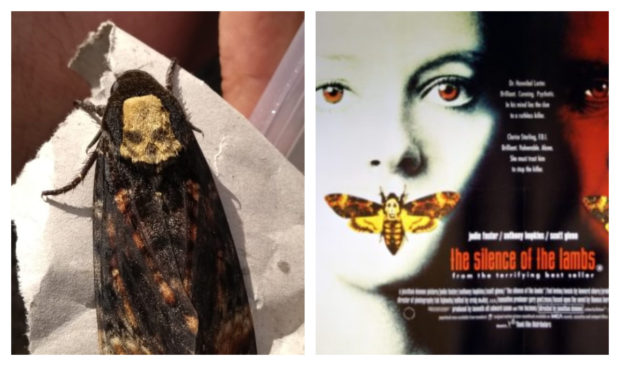A rare species of moth made famous by the spooky skull on its back and a leading role in The Silence Of The Lambs has been found stealing honey from an Aberdeenshire beehive.
The death’s-head hawk moth was discovered by beekeeper Ewan Campbell, a scientist from the Centre for Genome Enabled Biology and Medicine in Aberdeen.
Mr Campbell found the creepy crawly, which is rarely seen in the UK and even more uncommon in Scotland, when he was checking his personal hive in his back garden in Methlick.
The insect has become iconic in pop culture due to the skull-like pattern on its thorax, and has appeared in major films like 1958’s Dracula, starring Christopher Lee as the titular vampire.
But moth’s most memorable moment was in 1991’s The Silence of the Lambs, where it proved to be a key piece of evidence for Clarice Starling, played by Jodie Foster, in the hunt for serial killer Buffalo Bill.
Mr Campbell, who runs the Udny Provender honey business with his wife Liz, admitted his experience discovering the insect last week was almost as frightening as the movies that made it famous.
This was a first for me as a beekeeper – a deaths head hawk moth in the hive today drinking honey. So cool ! Any other #beekeepers seen them in North East Scotland? @fiona_bugsnbees @calluna4u @Scotbeekeepers @EastScotBees @RoyEntSoc pic.twitter.com/DNzRrF1dX1
— Ewan Campbell (@thehotbeard) June 19, 2019
He said: “We have a small beekeeping business with sites all over the north-east of Scotland.
“I had never seen anything like it.
“I was just going through the hive as usual, lifting up the frames where the bees live to make sure they’re all fine, when all of a sudden this huge black shape started making these weird noises and emerged from the hive flapping at me, it really gave me a hell of a fright.
“Compared to most moths, which are silent, these moths are able to make a chirping noise which is believed to scare away the bees and let it drink up the honey – they’re really quite cool.”
Mr Campbell added: “I’ve spoken to heaps of beekeepers across the UK over the last week, and none of them had really heard of them being spotted in their hives before, so it seems to be pretty unusual to say the least.
“There’s actually a lot of mythology attached to these moths that they’re a sign of disease, pestilence and war coming – but hopefully that won’t happen to our hives.
“We gave it a little bit of honey to cheer it up, and sent it on its way.”
